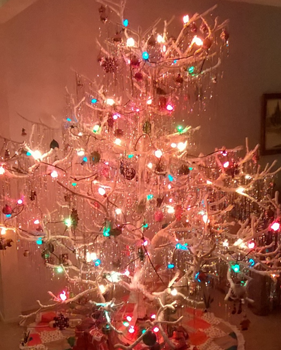Fall has been as colorful at the Robbins Hunter Museum as the glorious display of autumn color was on Village trees and the surrounding countryside. Giant spiders and pumpkins invited visitors inside to see the incredible collection of Halloween ephemera belonging to George and Jeanne Johnson of Logan, Ohio.
Mid-month, sixteen scarecrows invaded the garden, each made by a student at Welsh Hills School depicting a president or first lady. In addition to Halloween, Victoria Woodhull is prompting much interest as we get closer to election day. Talks by Jeff Gill and Sarah Wallace, the 2016 Victoria Woodhull Woman of Achievement recipient, drew enthusiastic crowds. A full page article in USA Today about Woodhull was reprinted on the front page of the Newark Advocate. One man came to see the exhibit with his copy of USA Today in hand!
Between now and the end of the year, focus will shift to the exhibit, Glorious Christmas. Thousands of white lights will illuminate the house and this year we will add lights to the Knobel Folly. Our members are invited to view the bedecked mansion at our annual Christmas Gala on November 12. Gingerbread Houses as well as Santa and Mrs. Claus will be featured at the Candlelight Walking Tour on December 3. This year for the first time, we will be open on Thursday evenings in December for “Nights Before Christmas,” an intimate evening in the candlelit house, by reservation. We have also added open hours for the last week in December.
In January, the Board of Trustees will hold a full-day retreat to examine our strategic plan, scheduled for completion next year. The coming year will also mark the announced completion of the Jill Griesse Historic Garden as well as the 175th anniversary of the Avery-Downer House. So we look forward to another year with many possibilities for celebration, with plans for exciting, enlightening, educational events.













